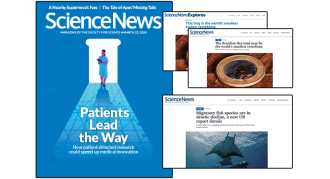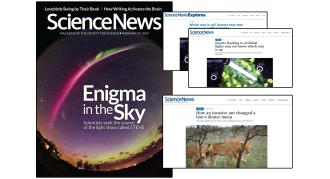Search Results

Forest Neutrino Detectors and 3D Vertebrate Anatomy
Have students explore an archive of 3D scans of vertebrate anatomy and form a scientific question and learn how scientists could use trees to help detect high-energy neutrinos using these lesson plans paired to articles from the April 6 issue of Science News.
A peek inside
Students will learn about the openVertebrate project and how it is digitizing vertebrate anatomy using CT scans. Then they’ll explore the archive, form a scientific question about one of the specimens and consider how to research that question.
Neutrino-detection issues? Time to tree-cruit!
Physicists propose that trees may help detect high-energy subatomic particles called neutrinos. Learn how Earth’s atmosphere alters these incoming high-energy subatomic particles from space. Then, explore how scientists could use this interplay to develop new ways to detect high-energy neutrinos.

Endangered Migratory Species and A Tiny Toad
Integrate two articles from the March 23 Science News issue to have students analyze and compare two graphs of endangered migratory species and answer questions on the smallest known species of vertebrate and amphibian, the Brazilian flea toad.
Data on dwindling migratory species
Students will analyze and compare two graphs to summarize a recent report about animals protected by an international treaty called the Convention on the Conservation of Migratory Species of Wild Animals before discussing the possible next steps and limitations of the treaty.
The Tiny “Toad” of Many Crowns
Scientists in Brazil have just discovered a creature that claims two small but fierce titles: the smallest known vertebrate and the smallest known amphibian. This raindrop-sized vertebrate earned a rather misleading name for itself — the “flea toad.” Use metric units to make and compare measurements and learn the differences between toads and frogs before discussing the misleading nature of the amphibian’s name.

Doggie Data and the April 8 Eclipse
Check out recent articles from the March 9 issue of Science News to have students explore data about their favorite dog breeds from a furry research study out of the U.K. and learn about different factors of the solar eclipse on April 8 that will make it especially rare for both scientists and observers.
Doggie data
Scientists in the U.K. have mapped the life spans of different dog breeds and found surprising links to body size and nose shape. In this short activity, students can explore data about their favorite dog breeds in a furry fun research study
All eyes on the sun
On April 8, 2024, approximately 32 million people may have the opportunity to see a total eclipse of the sun. Astronomers predict this eclipse will put on quite a show — one of the most vivid in recent history. Learn how different factors of this solar eclipse will make it especially rare for both scientists and casual observers.

Ant Ecosystem Disruption and Insects to Light
Use two articles from the February 24 issue of Science News to have students evaluate the data from a recent study and determine if the old saying, “like a moth to a flame” might need a revision and outline the cascading effects that one tiny ant species can have on a savanna-wide food web.
How an ant shook up an ecosystem
How can one tiny ant species cause a savanna-wide shift in the food web? Outline the cascading effects of the disruption of one mutual relationship and create graphs that highlight how an invasive species can have significant indirect effects on an ecosystem.
Drawn to a flame
That old saying, "drawn like a moth to a flame," needs a revision. Many flying insects may appear to be captivated by the glow of a nighttime lamp. But things aren't always what they seem. The reality turns long-held assumptions topsy-turvy. New findings suggest that flying insects are not attracted to the light at all, but actually turn their backs to it. Learn how new evidence challenges old theories and hypotheses while answering questions and discussing how the evidence from such studies supports conclusions.